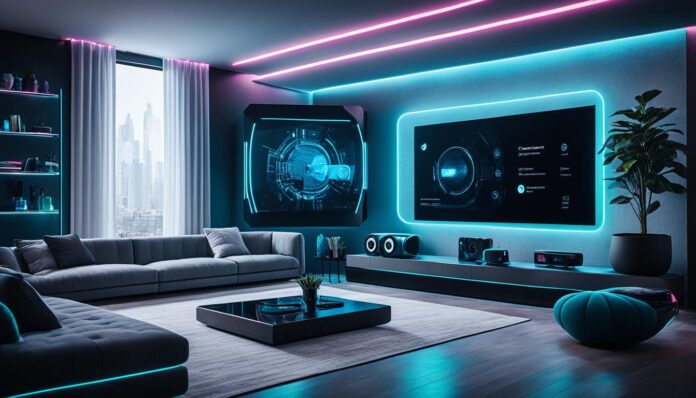
The world of smart home technology has been quickly evolving, with the number of smart households in the U.S. expected to grow to 77.05 million by 2025. However, as new smart devices and automation systems continue to infiltrate our homes, there are growing concerns around security and privacy. Homeowners must be cautious about the risks of interconnectivity, as hackers could potentially gain access to home networks and devices. Additionally, the complexity of managing multiple smart home products with different apps and interfaces has hindered wider adoption. To prepare your home for smart living in 2025, you’ll need to carefully evaluate the security and usability of smart home devices, as well as take steps to integrate them into a cohesive, voice-controlled system.
Key Takeaways
- The number of smart households in the U.S. is expected to grow to 77.05 million by 2025.
- Homeowners must be cautious about the risks of interconnectivity and potential security breaches.
- Managing multiple smart home products with different apps and interfaces can be challenging.
- Integrating smart home devices into a cohesive, voice-controlled system is crucial for a seamless smart living experience.
- Evaluating the security and usability of smart home devices is essential to ensure a safe and convenient smart home setup.
Embracing the Future of Connected Living
The Internet of Things (IoT) is driving the shift towards connected, automated homes. IoT devices and smart home systems allow homeowners to remotely monitor, control, and integrate various household functions, from lighting and temperature to security and appliances. By embracing the power of smart home automation, you can unlock a world of convenience, energy efficiency, and enhanced home security.
Understanding the Internet of Things (IoT)
The IoT ecosystem comprises a network of interconnected devices, sensors, and systems that can communicate with each other and be controlled remotely. These smart home technologies are designed to streamline your daily routines, providing you with greater control and visibility over your living environment. From voice-controlled assistants to energy-efficient appliances, the IoT is transforming the way we interact with our homes.
Benefits of Smart Home Automation
Smart home automation offers a range of benefits that can improve your quality of life and reduce your environmental impact. With connected devices and centralized control, you can enjoy increased convenience, energy savings, and enhanced home security. From remotely adjusting your thermostat to receiving alerts about potential intruders, smart home technologies empower you to live more efficiently and securely.
Assessing Your Current Home Setup
Before embracing the future of connected living, it’s important to evaluate your current home setup. Consider the existing devices, appliances, and systems you have in place, as well as your overall home networking capabilities. Identify areas where smart home automation can enhance your daily routines and address any security or efficiency concerns. By taking a thoughtful approach to your home’s readiness, you can ensure a seamless transition to a more connected and intelligent living experience.

How can I prepare my home for smart living in 2025?
To prepare your home for smart living in 2025, start by upgrading to a new generation of smart home devices that offer improved functionality, security, and integration. Look for products from reputable manufacturers that prioritize privacy and security, and ensure they can be easily connected to a central home automation platform or voice assistant.
Upgrading to Smart Home Devices
As the smart home technology landscape continues to evolve, take the opportunity to replace outdated devices with the latest generation of connected devices. Look for products that seamlessly integrate with your existing home networking setup and offer enhanced features like advanced smart lighting controls, remote access, and predictive maintenance capabilities.
Integrating Voice Control and Assistants
Incorporate voice-controlled assistants into your smart home setup to streamline the management of various household functions. By leveraging voice commands, you can effortlessly control energy-efficient appliances, adjust smart lighting, and monitor your home security systems without relying on multiple apps or interfaces.
Enhancing Home Security and Surveillance
Upgrade your home security by investing in advanced connected devices such as smart locks, surveillance cameras, and motion sensors. These technologies not only enhance the overall security of your home but also provide you with remote access and monitoring capabilities through your smartphone or voice assistant.
Optimizing Energy Efficiency
Integrate energy-efficient appliances and smart home automation systems to optimize your home’s energy usage. From programmable thermostats to intelligent lighting controls, these smart home technologies can help you reduce your carbon footprint and lower your utility bills, all while maintaining a comfortable living environment.
Conclusion
As the smart home technology landscape continues to evolve, homeowners have a unique opportunity to prepare their homes for the future of connected living. By upgrading to secure, integrated smart home devices from reputable brands like Amazon, Google, and Apple, you can leverage voice control and virtual assistants to create a technologically-advanced, yet comfortable and personalized living environment.
Additionally, by enhancing your home’s security and surveillance systems and optimizing energy efficiency through smart appliances and lighting, you can future-proof your home and enjoy the conveniences of smart living in 2025 and beyond. Remember to prioritize security and privacy when selecting your smart home products and stay informed on the latest advancements in this rapidly changing industry.
By embracing the benefits of smart home automation, you can unlock a new level of comfort, convenience, and control in your daily life. Prepare your home for the smart living of the future and unlock the full potential of connected technology to enhance your lifestyle and create a truly future-ready living space.
FAQ
What is the expected growth of smart households in the U.S. by 2025?
The number of smart households in the U.S. is expected to grow to 77.05 million by 2025.
What are the concerns around smart home technology and interconnectivity?
There are growing concerns around security and privacy, as hackers could potentially gain access to home networks and devices. The complexity of managing multiple smart home products with different apps and interfaces has also hindered wider adoption.
What are the benefits of smart home automation?
The benefits of smart home automation include increased convenience, energy efficiency, and home security.
What should I look for when upgrading to new smart home devices?
Look for products from reputable manufacturers that prioritize privacy and security, and ensure they can be easily connected to a central home automation platform or voice assistant.
How can I future-proof my home for smart living in 2025?
To future-proof your home, you can upgrade to secure, integrated smart home devices, leverage voice control and virtual assistants, enhance security and surveillance, and optimize energy efficiency.
